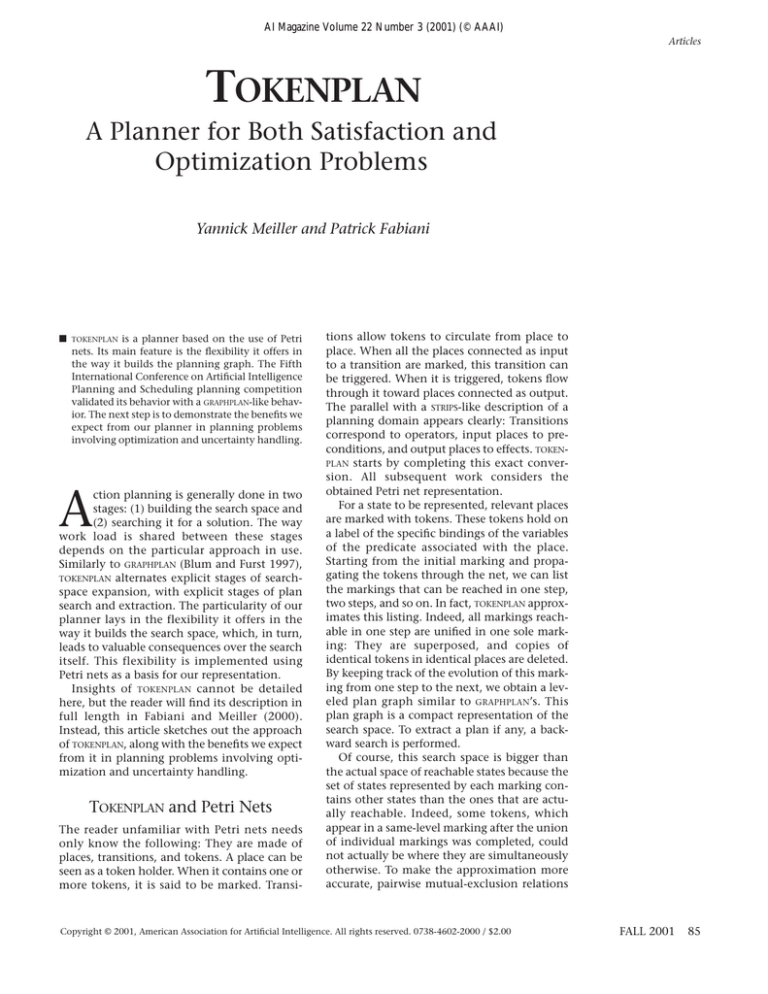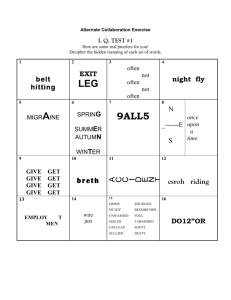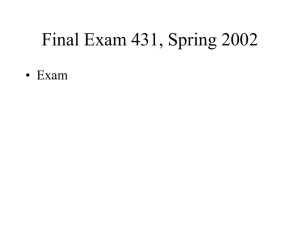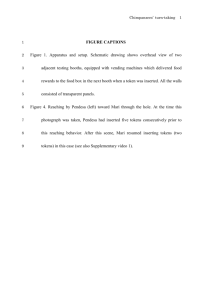
AI Magazine Volume 22 Number 3 (2001) (© AAAI)
Articles
TOKENPLAN
A Planner for Both Satisfaction and
Optimization Problems
Yannick Meiller and Patrick Fabiani
■
TOKENPLAN is a planner based on the use of Petri
nets. Its main feature is the flexibility it offers in
the way it builds the planning graph. The Fifth
International Conference on Artificial Intelligence
Planning and Scheduling planning competition
validated its behavior with a GRAPHPLAN-like behavior. The next step is to demonstrate the benefits we
expect from our planner in planning problems
involving optimization and uncertainty handling.
A
ction planning is generally done in two
stages: (1) building the search space and
(2) searching it for a solution. The way
work load is shared between these stages
depends on the particular approach in use.
Similarly to GRAPHPLAN (Blum and Furst 1997),
TOKENPLAN alternates explicit stages of searchspace expansion, with explicit stages of plan
search and extraction. The particularity of our
planner lays in the flexibility it offers in the
way it builds the search space, which, in turn,
leads to valuable consequences over the search
itself. This flexibility is implemented using
Petri nets as a basis for our representation.
Insights of TOKENPLAN cannot be detailed
here, but the reader will find its description in
full length in Fabiani and Meiller (2000).
Instead, this article sketches out the approach
of TOKENPLAN, along with the benefits we expect
from it in planning problems involving optimization and uncertainty handling.
TOKENPLAN and Petri Nets
The reader unfamiliar with Petri nets needs
only know the following: They are made of
places, transitions, and tokens. A place can be
seen as a token holder. When it contains one or
more tokens, it is said to be marked. Transi-
tions allow tokens to circulate from place to
place. When all the places connected as input
to a transition are marked, this transition can
be triggered. When it is triggered, tokens flow
through it toward places connected as output.
The parallel with a STRIPS-like description of a
planning domain appears clearly: Transitions
correspond to operators, input places to preconditions, and output places to effects. TOKENPLAN starts by completing this exact conversion. All subsequent work considers the
obtained Petri net representation.
For a state to be represented, relevant places
are marked with tokens. These tokens hold on
a label of the specific bindings of the variables
of the predicate associated with the place.
Starting from the initial marking and propagating the tokens through the net, we can list
the markings that can be reached in one step,
two steps, and so on. In fact, TOKENPLAN approximates this listing. Indeed, all markings reachable in one step are unified in one sole marking: They are superposed, and copies of
identical tokens in identical places are deleted.
By keeping track of the evolution of this marking from one step to the next, we obtain a leveled plan graph similar to GRAPHPLAN’s. This
plan graph is a compact representation of the
search space. To extract a plan if any, a backward search is performed.
Of course, this search space is bigger than
the actual space of reachable states because the
set of states represented by each marking contains other states than the ones that are actually reachable. Indeed, some tokens, which
appear in a same-level marking after the union
of individual markings was completed, could
not actually be where they are simultaneously
otherwise. To make the approximation more
accurate, pairwise mutual-exclusion relations
Copyright © 2001, American Association for Artificial Intelligence. All rights reserved. 0738-4602-2000 / $2.00
FALL 2001
85
Articles
are computed. The same rules as the ones for
computing GRAPHPLAN’s mutex relations are
applied (after being formulated in terms of
tokens). However, part of the mutex relations,
which we call permanent mutex, can be deduced
with no costly computation using colored
tokens. The idea is to use some “physical”
properties of tokens to embed some structural
properties of the planning domain. In some
cases, TOKENPLAN can avoid the explicit computation of nearly half the mutex relations
(nonubiquity of robots and balls in the gripper
domain, for example).
Control over the Level of
Splitting of the Search Space
The
particularity
of TOKENPLAN
is that it can
achieve both
levels of
splitting, and
also all the
intermediate
ones, using
different
classes of
tokens.
86
AI MAGAZINE
In a particular level of the plan graph, when
TOKENPLAN triggers a transition, it means it considers triggering it in all markings where its preconditions are marked. Similarly to GRAPHPLAN,
TOKENPLAN always considers the largest sets of
states that can be described in the domain language.
An FSS-like approach, however, would consider systematically every single state independently, checking whether a particular action
can be applied to it. In this case, the search
space is said to be totally split, whereas in a
GRAPHPLAN-like approach, there is no splitting at
all.
The particularity of TOKENPLAN is that it can
achieve both levels of splitting, and also all the
intermediate ones, using different classes of
tokens. Two tokens of different classes are different tokens, even though they might hold
identical labels, and they might mark a same
place. As different tokens, both of them will be
kept in the planning graph, which introduces
splitting. Moreover, to be triggered, a transition
needs to have all its precondition places
marked with tokens of the same class, ensuring
different pieces of search space will not be
mixed together.
If there is only one class, then TOKENPLAN has
a GRAPHPLAN-like behavior: As soon as its precondition places are marked, a transition can
be triggered, considering all the possible states
where these preconditions hold. Suppose now
that instead of a single class of tokens, a new
one is created each time a transition is triggered. Then each class corresponds to a single
state, and TOKENPLAN builds a search space in
the same way FSS would, introducing full splitting. Of course, lots of different class designs
are possible, leading to lots of intermediate
splitting strategies. Classes can be designed
according to the presence of such or such a feature but also according to some heuristics, or
even some thresholds of uncertainty or utility
for example.
Expected Benefits of
This Flexibility
We are interested in planning under uncertainty in dynamic environments for autonomous
systems. Our approach aims at making gametheoretic approaches more efficient by taking
advantage of the capabilities of classical AI
planning to handle sets of states instead of single states. The challenge is then to be able to
handle sets of states relevant to the criteria that
are to be optimized by the game-theoretic
approach, that is, to be able to control the level
of splitting of the search space.
No-splitting approaches are rarely adapted to
optimization because the sets of states they
handle are not necessarily coherent in regard
to the criteria that are to be optimized. For
example, two identical states will be unified,
although they might not have the same utility
value because of the way they have been
reached.
Total splitting approaches, based on a systematic discretization of the state space, such
as in Markov decision processes, can lead to an
excessive fineness of description and an excessively large state space, which, in turn, makes
any search in them untractable.
The idea behind controlling the level of
splitting is to be able to design at planning
time sets of states that are tailored for the planning task at hand. For example, classes might
correspond to utility regions in an optimization problem. Then the search for a plan could
be conducted at the level of the classes instead
of at the state level. It would be equivalent to
say that the initial systematic discretization is
abstracted up to the proper level to solve the
particular problem at hand. Another way of
using classes could be to limit the search space
to some of them. For example, each class could
correspond to a different possible initial state.
Then, a plan involving only tokens pertaining
to all classes would be a conformant plan. A plan
containing actions that depend on the class of
tokens would be a contingent plan.
Settings for the Competition
During the competition, we used settings corresponding to a GRAPHPLAN-like behavior (that
is, no splitting at all) because of TOKENPLAN’s
state of development at the time. Therefore,
automatic color encoding of part of the mutex
relations was used. The result of the competition validated TOKENPLAN’s “good” behavior
Articles
please join us!
■ member’s electronic library ■ national conference on artificial intelligence ■ discounts on ai books ■ innovative applications of artificial intelligence
■ discounts on journals ■ robot exhibition ■ spring symposium series ■ aaai press ■ fall symposium series ■ botball tournament ■ ai magazine
■ classic paper award ■ aaai fellows ■ allen newell award ■ distinguished service award ■ mobile robot competition ■ ai topics website ■ technical reports
■ grants for workshops, conferences, and symposia ■ electronic directory ■ online ai journal
american association for artificial intelligence
445 burgess drive ■ menlo park, california 94025 usa
www.aaai.org ■ membership@aaai.org
650-321-4457 ■ 650-321-4457 fax
compared to existing state-of-the-art approaches before we designed new splitting strategies.
This version was implemented in Lisp, with a
backward search adapted from the code kindly
provided by S. Kambhampati.
Conclusion and Future Works
This planning competition showed that recent
advances in AI planning such as GRAPHPLAN-like
approaches can be handled properly by TOKENPLAN . With these settings, its performances
position it in the main stream of current planning systems. However, the main benefits of
TOKENPLAN are expected with other types of
strategy for splitting the search space. We
sketched out how these could be designed to be
more suitable to uncertainty handling and
optimization in planning.
Our current work focuses on this last point.
We want to describe more formally the notion
of splitting of the search space. On the experimental side, diverse splitting strategies have to
be put through the test, first on deterministic
classical planning benchmarks and then on
planning problems dealing with uncertainty or
optimization. These tasks will aim at getting a
better feeling of the influence of the level of
splitting over planning performances. Eventually, we aim at getting some characterization of
splitting strategies and the problem classes
they should be applied to.
References
Blum, A., and Furst, M. 1997. Fast Planning through
Planning Graph Analysis. Artificial Intelligence
90:281–300.
Fabiani, P., and Meiller, Y. 2000. Planning with
Tokens. Paper presented at the Recent Advances in
Planning Workshop at the Fourteenth European
Conference on Artificial Intelligence, 20–25 August,
Berlin, Germany.
Yannick Meiller has started his
Ph.D. program at SupAéro and
works at ONERA on motion and
information gathering planning
under uncertainty under the
supervision of Patrick Fabiani. His
master’s thesis dealt with modular
neural command for behavioral
mobile robotics (under the supervision of B. Amy, IMAG Institute, 1998). Finally, he
had the opportunity to work on focusing GRAPHPLAN
with S. Kambhampati (Arizona State University) in
1997. His research interests include planning, reasoning under uncertainty, optimization, knowledge representation, and autonomous agents. His e-mail
address is meiller@cert.fr.
Patrick Fabiani graduated as
Ingénieur from Ecole Polytechnique in 1990 and then from
SupAéro in 1992. He obtained his
Ph.D. from SupAéro in 1996 on
the design of observation strategies
for a surveillance system in a
dynamically changing uncertain
world. He is a senior research scientist at ONERA in Toulouse and has been working
mostly on autonomous systems (helicopters, UAVs,
UUVs, and so on) and more recently on airport
ground traffic control. In 1997 to 1998, he was in the
Robotics Lab in the Computer Science Department at
Stanford University as a visiting scholar in J.-C.
Latombe’s research group. His research interests
include decision, planning, reasoning under uncertainty, situation assessment, and autonomous
agents. His e-mail address is fabiani@cert.fr.
FALL 2001 87






